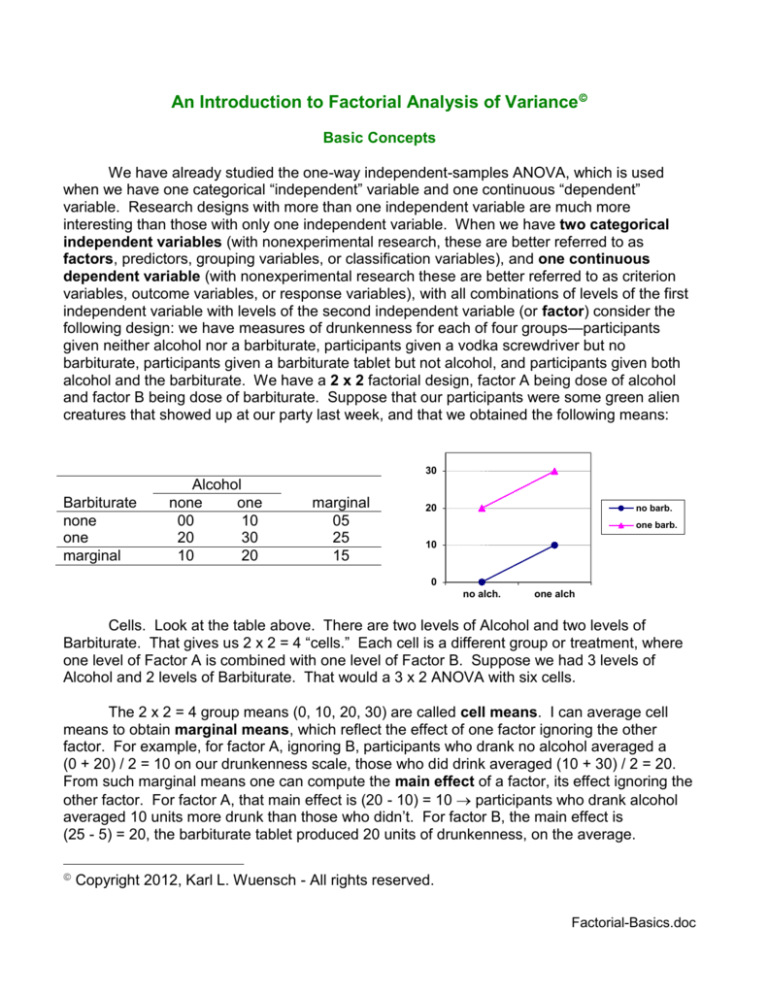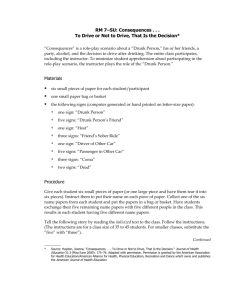
An Introduction to Factorial Analysis of Variance
Basic Concepts
We have already studied the one-way independent-samples ANOVA, which is used
when we have one categorical “independent” variable and one continuous “dependent”
variable. Research designs with more than one independent variable are much more
interesting than those with only one independent variable. When we have two categorical
independent variables (with nonexperimental research, these are better referred to as
factors, predictors, grouping variables, or classification variables), and one continuous
dependent variable (with nonexperimental research these are better referred to as criterion
variables, outcome variables, or response variables), with all combinations of levels of the first
independent variable with levels of the second independent variable (or factor) consider the
following design: we have measures of drunkenness for each of four groups—participants
given neither alcohol nor a barbiturate, participants given a vodka screwdriver but no
barbiturate, participants given a barbiturate tablet but not alcohol, and participants given both
alcohol and the barbiturate. We have a 2 x 2 factorial design, factor A being dose of alcohol
and factor B being dose of barbiturate. Suppose that our participants were some green alien
creatures that showed up at our party last week, and that we obtained the following means:
30
Barbiturate
none
one
marginal
Alcohol
none
one
00
10
20
30
10
20
marginal
05
25
15
20
no barb.
one barb.
10
0
no alch.
one alch
Cells. Look at the table above. There are two levels of Alcohol and two levels of
Barbiturate. That gives us 2 x 2 = 4 “cells.” Each cell is a different group or treatment, where
one level of Factor A is combined with one level of Factor B. Suppose we had 3 levels of
Alcohol and 2 levels of Barbiturate. That would a 3 x 2 ANOVA with six cells.
The 2 x 2 = 4 group means (0, 10, 20, 30) are called cell means. I can average cell
means to obtain marginal means, which reflect the effect of one factor ignoring the other
factor. For example, for factor A, ignoring B, participants who drank no alcohol averaged a
(0 + 20) / 2 = 10 on our drunkenness scale, those who did drink averaged (10 + 30) / 2 = 20.
From such marginal means one can compute the main effect of a factor, its effect ignoring the
other factor. For factor A, that main effect is (20 - 10) = 10 participants who drank alcohol
averaged 10 units more drunk than those who didn’t. For factor B, the main effect is
(25 - 5) = 20, the barbiturate tablet produced 20 units of drunkenness, on the average.
Copyright 2012, Karl L. Wuensch - All rights reserved.
Factorial-Basics.doc
Page 2
A simple main effect is the effect of one factor at a specified level of the other factor.
For example, the simple main effect of the vodka screwdriver for participants who took no
barbiturate is (10 - 0) = 10. For participants who did take a barbiturate, taking alcohol also
made them (30 - 20) = 10 units more drunk. In this case, the simple main effect of A at level 1
of B is the same as it is at level 2 of B. The same is true of the simple main effects of B—they
do not change across levels of A. When this is the case, the simple main effects of one factor
do not change across levels of the other factor, the two factors are said not to interact. In such
cases the combined effects of A and B will equal the simple sum of the separate effects of A
and B—for our example, taking only the drink makes one 10 units drunk, taking only the
barbiturate makes one 20 units drunk, and taking both makes one (10 + 20) = 30 units drunk.
The combination of A and B is, in this case, additive.
Look at the interaction plot next to the table above. One line is drawn for each simple
main effect. The lower line represents the simple main effect of alcohol for subjects who had
no barbiturate, the upper line represents the simple main effect of alcohol for subjects who had
one barbiturate. The main effect of alcohol is evident by the fact that both lines have a slope.
The main effect of barbiturate is evident by the separation of the lines in the vertical dimension.
Suppose that we also conduct our experiment on human participants and obtain the
following means:
40
Barbiturate
none
one
marginal
Alcohol
none
one
00
10
20
40
10
25
marginal
05
30
17.5
30
no barb.
20
one barb.
10
0
no alch.
one alch.
Note that I have changed only one cell mean, that of the participants who washed down
their sleeping pill with a vodka screwdriver (a very foolish thing to do!). Sober folks taking only
the drink still get (10 - 0) = 10 units drunk and sober folks taking the pill still get (20 - 0) = 20
units drunk, but now when you combine A and B you do not get (10 + 20) = 30, instead you get
(10 + 20 + 10) = 40. From where did that extra 10 units of drunkenness come? It came from
the interaction of A and B in this nonadditive combination. An interaction exists when the
effect of one factor changes across levels of another factor, that is, when the simple main
effects of one factor vary across levels of another. For our example, the simple main effect of
drinking a screwdriver is (10 - 0) = 10 units drunker if you have not already taken a pill, but it is
twice that, (40 - 20) = 20, if you have. The screwdriver has a greater effect if you already took
a pill than if you haven’t. Likewise, the simple main effect of taking a pill if you already drank,
(40 - 10) = 30 units drunker, is more than the simple main effect of taking a pill if you did not
already drink, (20 - 0) = 20.
Page 3
The interaction between alcohol and barbiturates that we are discussing is a
monotonic interaction, one in which the simple main effects vary in magnitude but not in
direction across levels of the other variable. Alcohol increases your drunkenness whether or
not you have taken a pill, it just does it more so if you have taken a pill. Likewise, the pill
increases your drunkenness whether or not you have taken a drink, it just does so more if you
have been drinking. With such a monotonic interaction, one can still interpret main effects—in
our example, drinking alcohol or taking a pill increases drunkenness. In the plot, the fact that
the two lines are not parallel indicates that there is an interaction. The fact that the direction of
the slope is the same (positive) for both lines indicates that the interaction is monotonic.
Sometimes the direction of the simple main effects changes across levels of the other
variable. In such a case the interaction may be described as a nonmonotonic interaction.
For example, consider the following means from a group of purple aliens who crashed our
party:
30
Barbiturate
none
one
marginal
Alcohol
none
one
00
20
30
10
15
15
marginal
10
20
15
20
no barb.
one barb.
10
0
no alch.
one alch
Alcohol has absolutely no main effect here, (15 - 15) = 0, and the barbiturate does, but
the interesting effect is the strange interaction. For purple aliens who took no barbiturate the
simple main effect of a drink was to make them (20 - 0) = 20 units more drunk, but for those
who had taken a pill the simple main effect of the drink was to make them (10 - 30) = 20 units
less drunk. Likewise, the effect of a pill for those who had not been drinking was (30 - 0) =
+30, but for those who had been drinking it was (10 - 20) = -10.
The presence of such a nonmonotonic interaction may make it unreasonable to interpret
the main effects. For example, asked what the effect of alcohol is on purple aliens, you cannot
honestly answer, “It makes them more drunk.” You must qualify your response, “If they
haven’t been abusing barbiturates, it makes them more drunk, but if they have been abusing
barbiturates it makes them less drunk.”
The plot for our purple aliens makes it clear that the interaction is nonmonotonic -- the
direction of the slope for the one line is positive, for the other it is negative.
In a three-way factorial design (three categorical independent variables) one can
evaluate three main effects (A, B, and C), three two-way interactions (A x B, A x C, and B x C)
and one three-way interaction (A x B x C). A three-way interaction exists when the simple
two-way interactions (the interaction between two factors at each level of a third factor) differ
from one another. For the contrived data with which we have been playing, consider the third
factor, C, to be species of participant, with level one being Alienus greenus, level two being
Page 4
Homo “sapiens,” and level three being Alienus purpurs. We have already seen that the A x B
interactions differ across levels of C, so there is indication of a triple interaction in our 2 x 2 x 3
design.
You should be able to generalize the concepts of main effects, simple effects, and
interactions beyond the three-factor example we used here, but do not be surprised if you have
trouble understanding higher-order interactions, such as four-way interactions—most people
do—three dimensions is generally as many as a “Homo sapiens” can simultaneously handle!
Two-Way ANOVA: The Hypotheses
Now that we have the basic ideas of factorial designs, let us discuss the inferential
procedure, the ANOVA. We generally have sample data, not entire populations, so we wish to
determine whether the effects in our sample data are large enough for us to be very sure that
such effects also exist in the populations from which our data were randomly sampled. For our
two-way design we have three null hypotheses:
1.
1 = 2 = . . . = a
That is, the mean of the dependent variable is constant across the a levels of
factor A.
2.
1 = 2 = . . . = b
That is, Factor B does not affect the mean of the dependent variable.
3.
Factors A and B do not interact with one another, A and B combine additively to
influence the dependent variable.
Copyright 2014, Karl L. Wuensch - All rights reserved.
Be sure to complete the exercise on Interaction Plots.









